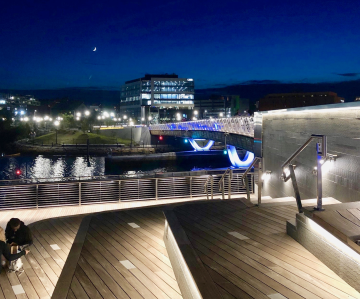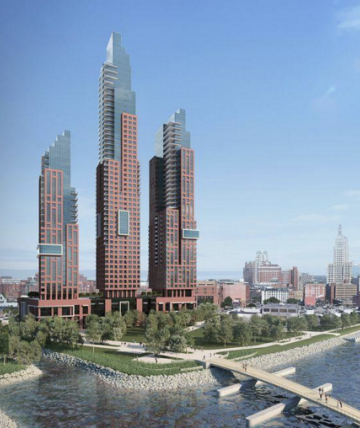How to Save a City: Architecture Critic Will Morgan
Thursday, October 03, 2019
Enough praise has been heaped on the Providence River Pedestrian Bridge, so we needn't dwell anymore on its design. But we do need to heed the lessons of this wildly successful downtown thoroughfare.
The bridge is an urban amenity that is free. On a recent Sunday night stroll, my wife and I were the oldest people in the crowd enjoying the bridge.
The new bridge is an example of the sort of creative thinking that convinced my wife and me to move to Providence twenty years ago.
GET THE LATEST BREAKING NEWS HERE -- SIGN UP FOR GOLOCAL FREE DAILY EBLASTAs city watchers, we made a list of what we wanted in our ideal city: seacoast colleges and universities, sidewalks, ethnic diversity, independent bookstores, proximity to the rest of New England.
But two things impressed us the most when Carolyn and I came to check out Providence: WaterFire, and the fact that the city was actually removing the parts of I-195 that had insensitively cut across the city.
Believing that how a city makes it waterfront available to its citizens is key to its livability, we were amazed by the Lazarus-like resurrection of the river in the heart of downtown.
For us, having Providence's version of New York's High Line where there used to be an ugly highway, is like coming full circle.
Something as simple as a pedestrian bridge that joins two banks of the river should reinforce the idea that city planning is not rocket science.
Appealing cities are those that are based on a human scale.
Cities are collections of people, and people like to promenade, to watch other people and be seen, to shop, and to drink coffee and dine al fresco.
The most desirable urban places are those that cater to walkers and cyclists, and which have other goals than a proliferation of garages and parking lots.
The way to save and enrich a city is through amenities like the bridge, abundant parks, and a vibrant cultural scene.
Conversely, big, overwrought, and all-dollars-and-no-sense mega-projects like the 46-story Hope Point Tower will take people from the streets, and create a ghetto for wealthy, disengaged people who prefer elevators to urban interaction.
Developers and the building trades tend to believe that only a city-destroying turkey such as the so-called Fane Tower will save the city, when there ought to be plenty of work and development opportunities in incremental development.
Notice how Ives Street in Fox Point is reinventing itself through a series of intriguing shops and small eateries? Aleppo Sweets is one of the nominees for Bon Appetite magazine's Fifty Best Restaurants of 2019.
Former Eagle Super Market on Ives Street currently undergoing renovation as an upscale restaurant (William Morgan)
Just think of how Seven Stars Bakery energized and transformed neighborhoods in Mount Hope, Broadway, and Rumford.
Imaginative development does not necessarily need massive infusions of cash from public coffers. What if the $25 million offered to Jason Fane were used instead to fill potholes, increase police patrols on foot, bicycle, and horseback, and to plant fields of sunflowers?
It would help if we stopped to confusing real estate with architecture.
Most of the schemes planned for the I-195 land are bland boxes. Can't we do better than the same-old ratio of dollars-per-square-foot? How about some aspiration symbolism, and attention-grabbing design?
And instead of selling ourselves to snake oil salesmen, why not charge outsiders wanting to build here to pay for the privilege of being part of our special city?
Having architects and other design professionals on the various boards that plan the city, as well as some visually literate politicians, would be beneficial.
Nevertheless, you do not need to be a RISD graduate or an architecture critic to assess the value of new development schemes. Just ask yourself: Would you travel to Europe to see this building?
If such a projected element doesn't offer anything above the ordinary, then it should be rejected.
Providence Station, the scheme to tempt Amazon to put its eastern headquarters in Rhode Island was an embarrassingly dreary mix of Shanghai, Brasilia, and Houston
If we want to continue to call ourselves the Creative Capital, it is time to realize that creative design needn't cost more than the same tired developers' schlock.
Good design, as the new bridge demonstrates, pays dividends.
William Morgan was the architecture critic for the Louisville Courier-Journal many years ago. His column, entitled the Urban Environment, was nominated for the Pulitzer Prize in criticism.
Related Articles
- Grace Church - One of Prov’s Great Architectural Treasures: Architectural Critic Will Morgan
- Architectural Critic Will Morgan: The New Un-Improved Tower
- Tower Swindle: Phase One—Architectural Critic Will Morgan
- “God is in the [Downtown] Details” - Architectural Critic Will Morgan
- Future of the Past, Providence Style - Will Morgan
- Architectural Critic Will Morgan Challenges the Three Hope Towers Design
- Architectural Critic Will Morgan: How We Look
- Architectural Critic Will Morgan: Providence River Pedestrian Bridge
- New RISD Student Center a Design Disappointment in Providence: Architectural Critic Will Morgan
- Architectural Critic Will Morgan: Superman Building
- Wexford Is a Modern Delight: Architectural Critic Will Morgan
- Guest MINDSETTER™ Deckman: Will Morgan’s Innovations and Invitations Reinvigorate RI?
- Good Design on Thayer Street: Architectural Critic Will Morgan










